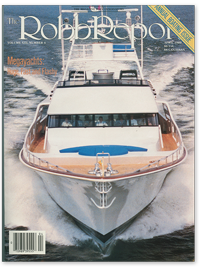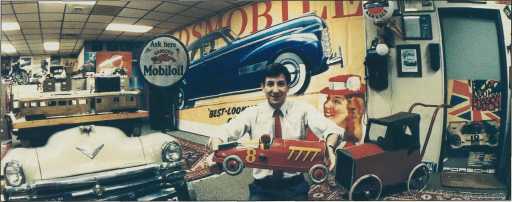
The Robb Report 1989
A Life’s Work – Walter Miller is a man with a focus
|
|
||||
 |
||||
|
|
||||
|
A Life’s Work
Walter Miller is a man with a focus. Perhaps the only entrepreneur in existence who began active career training at the age of 6, Miller has never since looked sideways.
He is the world’s largest collector of auto literature. More than a million pieces of it—showroom brochures, catalogs, owners’ manuals, repair manuals, photos, postcards and posters—it is a collection that spans nearly a century of automotive history. No museum or collector could match it; none would even try. For the auto buff in search of an early Packard brochure, for instance, Walter Miller would be the first call; when an attic cleaning turns up a trunk of old car posters, again Miller gets the call. As often as not, he’ll make an offer over the phone.
"You could say I was a fanatic, I suppose," he says. "I’d drive hundreds of miles for a shoebox containing a few brochures. Thousands of miles if there was an attic full of them."
It is an odyssey that never ends, and probably never will.
|
"There have been more than 5,000 cars and trucks manufactured in the U.S. since the 1890s," Miller says. "And nearly every one of them printed some kind of literature to promote their venture."
Walter Miller is 33; 27 years ago, he clipped his first car ad from a magazine. Slowly, over time, a hobby grew to an obsession—and finally to a business.
"This is definitely an avocation that turned into a vocation," he says. "When I started collecting auto ads as a boy, I had no idea it would turn into this."
"This," as he refers to it, is Walter Miller’s Antique Car Literature, a business that has taken its founder to more than 40 countries in search of fresh material, and that boasts customers in more than 100.
"It takes a while to get started in this business," he says. "People who are interested in this kind of thing fall into two general categories—the hard-core literature enthusiasts, and the owners of a special old car—say a ’57 Cadillac— who want all the literature that went with the car. Both are very selective; they don’t want just anything."
|
Miller gets more than 1,000 inquiries a week, he says, coming from enthusiasts around the world.
"I’ll answer anyone who calls or writes. I can usually tell just from the description if it’s something I’m looking for… and I’ll make an offer on the spot. That’s pretty much the way I find things—a little here, a little there."
Every once in a while, he says, comes news of a mother lode of old literature: a house or barn full of catalogs, manuals, brochures, or other archival matter.
And it comes from the strangest places. One prospective source, he says, took him through a house in which every room was stacked head-high with old newspapers; on the back porch were five years’ worth of Campbell soup cans and neatly stacked TV-dinner trays.
Miller was about to take his leave when the man ushered him into the garage: Both it and the attic were overf low-ing with auto and motorcycle literature—posters, owner’s manuals, brochures and showroom catalogs from the ’20s and ’30s.
"The thing about collecting all this is that when you’re lucky enough to find it
|
||
|
|
||||
 |
||||
|
|
||||
|
Walter Miller’s phenomenal collection of automobilia began as a pastime and became his life’s pursuit.
18/THE ROBB REPORT, APRIL 1989
|
||||
|
|
||||
|
|
||
 |
||
|
|
||
|
you’ve got to buy it—no matter how much of it there is. Or drive and get it—no matter how little there is. Some of the literature is downright obscure. Take the 1930 Packard catalog—I have a dozen customers waiting for the next one I find."
Miller’s office in Syracuse, N. Y., is a monument to his obsession. Automotive memorabilia are stacked, hung or piled in every corner. The earliest "vanity plate" on record—a 1903 New Jersey license plate with handsewn metal numbers on a leather background—sits on a shelf. Nearby, a 1959 racing poster from Havana, announcing the last car race before Castro’s rise to power eliminated such capitalist pursuits, shares space with a 1941 Oldsmobile billboard that survived only because an agent was too lazy to mount it. There are photos of various movie stars and presidents at promotional events; a 1920 model for a U.S. patent, depicting a wooden arm and hand for use as a turn signal; dozens of letters from such pioneers as Henry Ford, Charles Nash, Dr. Porsche and others; a 1959 Ford Motor Company internal memo discontinuing the Edsel; an 1842 written record of U.S. Senate proceedings regarding a proposed cross-country toll road for steam-powered wagons. The collection would be a tribute to the search committee of a major museum, but Miller’s singular devotion is behind every item.
Not all of the inquiries he receives, though, are from collectors. Rock groups and production companies have purchased brochures as a means of researching antique car videos; local police departments have borrowed or bought literature to aid in the identification of old cars. Some time ago, a New York murder victim had been last seen by witnesses near an old red pickup of indefinite vintage; state police borrowed several old Chevy and Ford truck brochures, showed them to witnesses for identification, and located and apprehended the killer.
More recently, a man contacted Miller to ask if he wanted to buy 25,000 Delo-rean brochures: "I declined, but was curious why he had so many. It turned out he was the printer, and when Delo-rean went belly-up he was stuck with the brochures and no payment."
Another request was from an attor-(Continued on page 83)
|
||
|
|
||
|
|
||
 |
||
|
|
||
|
(Continued from page 20) ney looking for paint samples from Ford and Mercury models between 1950 and 1980. The lawyer, Miller recalls, "was handling a multimillion-dollar suit involving a toxic dump site. His client was alleging that over the years the factory that produced the paint for Mercury had dumped excesses illegally [on his property]. That one’s still in the courts."
Still, the bulk of requests come from collectors, and are driven by nostalgia. Some of his callers, Miller says, seek not only the original brochure announcing a car model, but every printing that followed it.
"Some of the brochures were reprinted several times in a year. The auto company would add a chrome stripe, and all the photos and illustrations would change. Each change required another printing. The real enthusiast wants every single printing of a given brochure. … I have a great many in inventory."
Ultimately, Walter Miller says, his role is that of middleman.
"I guess what this business is all about is giving this literature new life. I find it lying around somewhere, unknown and unappreciated, and collect it in one spot for the enthusiasts."
For more information contact Walter Miller, 6710 Brooklawn Pkwy., Syracuse, NY 13211; telephone (315) 432-8282.
|
||
|
|
||


